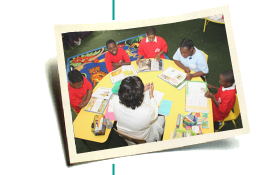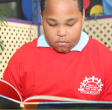
THE READING PROGRAM

If a child can't read, he or she can't do math, science, world studies or other course work. So the Hand-in-Hand Foundation launched Read a Book, See the World, a reading program for about 100 at-risk children at Mason Elementary School in Detroit. The program is based on the belief that a book can mentally transport a child to a different place while reading, taking the child across time, lands and cultures.
- Individual student instruction in small groups
- Five professional reading teachers...at no cost to the school (view images)
- Considerable time spent on basics and fundamentals at a pace tailored to each individual child's ability
- Two air-conditioned, carpeted and brightly painted reading rooms designed to look like ecosystems (rain forest, desert, mountains, etc.) with the intent of creating a motivating environment that teaches about different parts of the world (view images)
- Monthly visits by business professionals who read to the children in classrooms throughout the school (view images)
- Special activities, speakers, authors and themed visitors
- Daily progress meetings between reading teachers and regular classroom teachers
- A dedicated library of children's books provided by Hand-in-Hand
- Computerization of the school's main library by Hand-in-Hand to replace the school's old reference area
Learning by Linkages
The Read a Book, See the World reading program seeks to provide at-risk children with the individual time, attention and fundamentals they need for learning by creating linkages. Children learn the meaning of words in the context of what they already know. For example, a child is likely to internalize the meaning of "aunt and uncle" in the context of "brother and sister." However, such basic building blocks often are not available to at-risk children. According to the Atlanta INtown, a popular community newspaper, a child from a typical low-income family experiences only 25 hours of one-on-one picture book reading by the time he or she enters the first grade. A child from an average middle class family, in contrast, experiences up to 1,700 hours of one-on-one reading.


